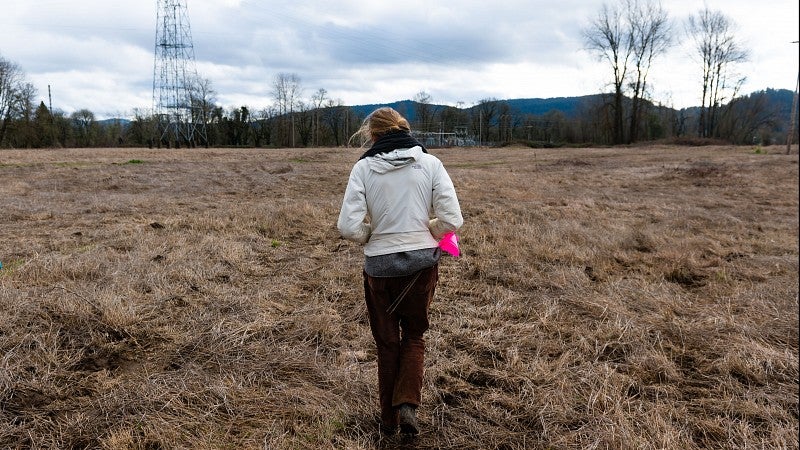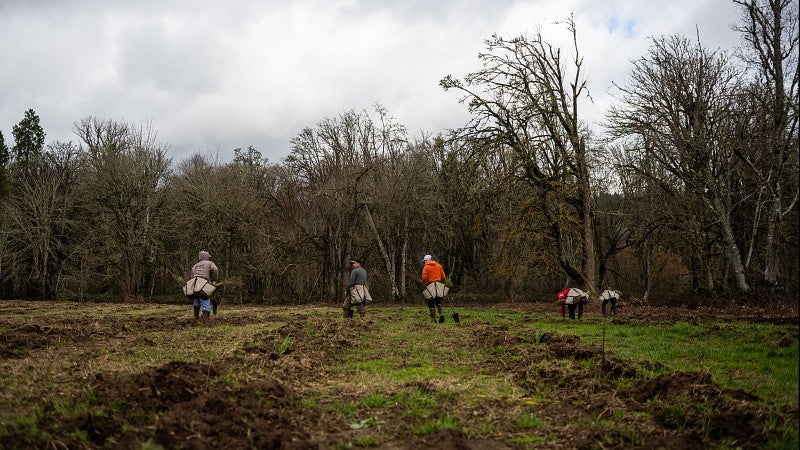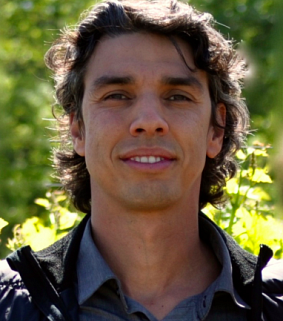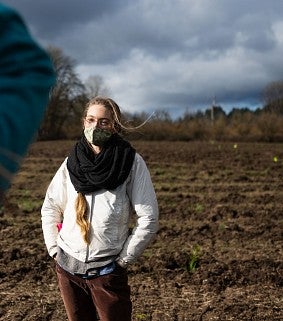
Research focused on solutions for the challenges of land degradation and climate change impacts on natural and human-engineered ecosystems.
One of trees' most basic functions is to make their own food from sunlight and carbon dioxide. Trees reduce and ultimately store atmospheric carbon in this process, known as carbon sequestration.
Because of this, tree planting is promoted as a way to offset emissions. It even has the potential to generate increasingly valuable carbon credits. But as carbon sequestration is commodified, important questions arise. What kinds of plants and trees sequester the most carbon? What is the best long-term planting method?
These are the research questions for Soil Plant Atmosphere Lab at UO in a pilot study contracted by the Eugene Water & Electric Board and funded by a National Science Foundation Convergence Grant. The experiment is on a 12-acre fallow field in Springfield near the McKenzie River, part of a 140-acre parcel EWEB recently bought from Weyerhaeuser Company.
The utility owns a substation on a small corner of the property, and acquired the remaining property to support its water source protection goals. The dual benefits of protecting the McKenzie River watershed and potential carbon sequestration make this a unique opportunity for EWEB and its customers, said Karl Morgenstern, EWEB's watershed restoration program manager.
"The EWEB-UO partnership is advancing our community's most vital resources today while developing methods and technologies to address climate change in the future," Morgenstern said.
Students working in the SPA Lab spent the summer on the parcel, taking botanical inventory, measuring soil cores for carbon content and developing a design for the planting experiment, said lab project manager Hilary Rose Dawson.

Consulting with EWEB-contracted forester Matt Fehrenbacher of Trout Mountain Forestry, the lab team chose species to mimic the existing plant community. Douglas fir, incense cedar, ponderosa pine, cottonwood, bigleaf maple, ash and white oak are the tree species, and shrubs include osoberry, cascara, Oregon grape, snowberry, ninebark and creek dogwood.
Planted in early February, the young trees and shrubs have time to get established before the summer heat. The lab team will monitor carbon levels as the trees grow in various treatments, such as hardwood-only, conifer-only, mixed tree and shrub, and shrubs only.


Another important consideration is how the planted forests will burn if a wildfire moves through them.
"How do we balance out the benefit of more trees, possibly gaining more carbon, versus keeping those trees far enough apart that they don't all catch fire all at once should a wildfire come through? There's so many questions, and there aren't any answers yet," Dawson said.
Eventually, EWEB will scale up the lab's research findings to other properties it owns in the southern Willamette Valley, and it could even be used to restore areas damaged by wildfire.

How are trees planted to measure carbon?
Why is EWEB interested in the study?
What is the impact of the research?

Lucas Silva
Principal Investigator
Associate Professor of Environmental Studies and Geography at UO. Founder and director of the Soil Plant Atmosphere Research Lab, which is dedicated to the study of socio-ecological processes that affect carbon, water and nutrient cycles. His research integrates concepts and methods from different quantitative disciplines to improve sustainable land use and conservation for climate change mitigation.

Hilary Rose Dawson
Project Manager
Botanist interested in how plants vary over time and space. Dawson earned her bachelor's degree in Human Ecology from College of the Atlantic in 2018 and now researches plant ecophysiology as a member of the SPA Lab. As project manager, she appreciates the chance to connect theoretical research with hands-on, solutions-focused applications that meet the needs of local community partners.

Jamie Wright
Ph.D. Student
Doctoral candidate in Environmental Sciences, Studies and Policy at UO. Studying environmental ecology with an emphasis in soil science and paleoecology. Her research is motivated by understanding carbon dynamics such as sequestration and stability in tropical and temperate ecosystems. This project rewards her with the chance to use her skillset in a hands-on approach.

2021 CEF/Mellon Faculty Summer Research Award
Lucas Silva and Jon Bellona
“Soundscapes of Socioecological Succession: An Interdisciplinary Record of Resilience to Wildfire.”
About the Soil Plant Atmosphere Lab
